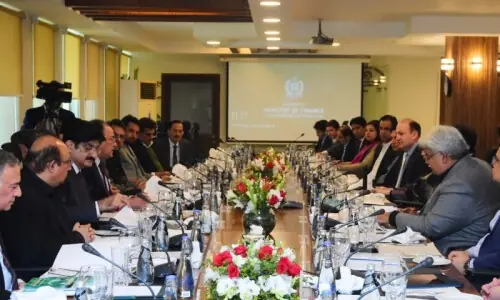THE federal budget for 2020-21 due today and the provincial budgets to follow are set to be announced in extraordinary times.
In order to be relevant and meaningful, government budgets have to be responsive to the macroeconomic context, be based on realistic assumptions, and have an anchoring theme or reform idea set in the medium term, rather than merely be an accounting statement for the year ahead.
However, this budget will be unlike any other. It is set in difficult circumstances with an exceptional degree of uncertainty generated by Covid-19. The impact of the pandemic on countries is via three overlapping channels:
• The ‘exogenous’ economic disruption caused by the pandemic (upended supply chains, halted global transportation and logistics links, interrupted flow of goods, people, investment and capital);
• The ‘endogenous’ economic disruption caused in response to the pandemic via lockdowns and other suppression measures (closed factories, businesses and markets);
• The public health effect (productivity loss, absenteeism, reluctant consumers, fiscal and other costs associated with Covid-19).
Collectively, this translates into collapsing growth, failing businesses, plummeting exports and massive pressure on millions of jobs. To amplify the challenges facing budget-makers, the threat of another pestilence looms in the year ahead (locusts), while the domestic troubles of India’s ruling party provide it with growing casus belli against Pakistan.
Weak economic growth in FY21 (possibly below two per cent at best), the re-appearance of inflationary pressure due to the recent rise in international oil prices, and growing debt servicing pressures translate into a constrained fiscal envelope. However, despite these very real constraints and trade-offs, the overriding focus of this budget should be to protect productive capacity in the economy from being shut down ‘permanently’.
Avoiding large-scale job losses and hysteresis, or ‘economic scarring’, is the number one priority for policymakers around the world — as it should be for our budget makers — along with allocations for the public health response.
In order to be relevant, the budget will need to be based on realistic revenue projections. With economic growth in FY21 expected at around two per cent, inflation likely to come in at seven to eight per cent, and tax elasticity of less than 1, for the budget to be tax-neutral it should aim for tax collection of no greater than Rs 4.3 trillion.
The IMF’s suggested target of Rs 5.1 trillion, a 32 per cent increase from the expected FBR tax collection for the outgoing fiscal year, is unrealistic, negates the finance minister’s ‘no new tax’ declaration, and implies a higher tax burden on businesses than warranted under the circumstances.
Given the lack of tax handles, the PSDP and provincial ADP allocations may need to be rationalised as well as re-appropriated away from longer gestation projects with high planning and implementation lags.
Salaries of government employees will also need to be frozen, while savings from improved debt management need to be targeted.
Beyond these measures, the need for fiscal consolidation will have to be kept in abeyance for much of FY21 until the productive sectors of the economy are out of the woods. Unfortunately, this will entail tolerance for a higher-than-recommended budget deficit for yet another fiscal year. However, this should not mean that the government should completely give up on reforms. While it should avoid a revenue enhancement focus in the budget, it can apply itself more seriously to reform of tax administration, public expenditure and debt management.
Finally, in view of the large uncertainties associated with the impact on economic activity, revenue and expenditure requirement well into the next fiscal year, it may be prudent for the finance minister to present a three- or four-month ‘rolling’ budget.
The budget can incorporate flexibility into discretionary expenditures and the PSDP by making block allocations rather than project- or item-specific allocations. A large ‘Covid-19 contingency’ block allocation can also be made, with subsequent final allocations to expenditure heads as needed.
This method of budgeting will allow expenditure flexibility at a time of evolving resource-availability and spending requirements caused by the Covid-19 situation.
The writer is a former member of the prime minister’s economic advisory council, and heads a macroeconomic consultancy based in Islamabad
Published in Dawn, June 12th, 2020


































